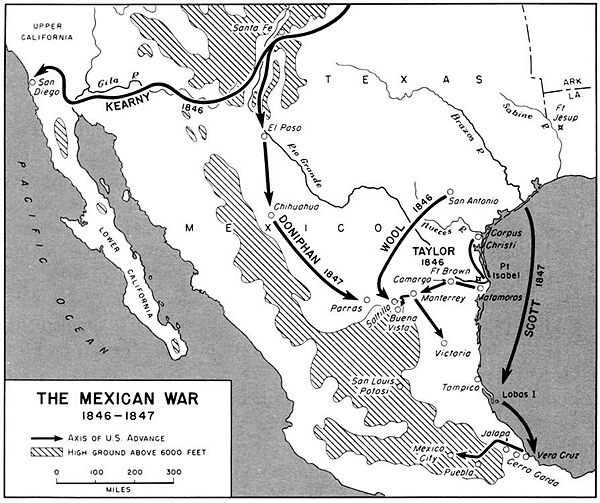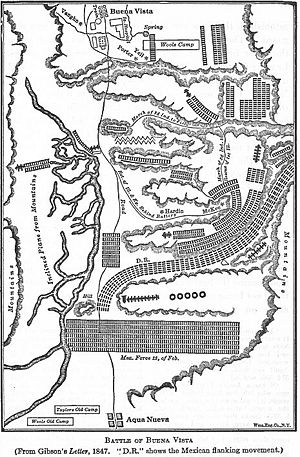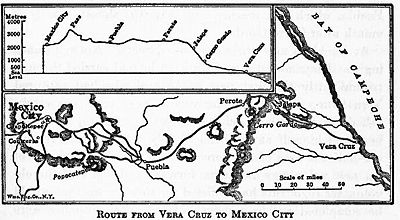Mexican-American War
The Mexican-American War (1846-48) was fought over control of Texas. Mexico lost all the battles and in the peace treaty gave up northern territories in exchange for $15 million.
Causes
Long-term causes
Perceptions of each side
Inside the U.S.
Along the border
Delay (2007) and Reséndez (2004) explain the American need to suppress Indian raids originating from Mexican territory. During the 1830s and 1840s, northern Mexico experienced a terrifying increase in interethnic violence as Comanches, Kiowas, Apaches, and other Indians attacked Mexican settlements across nine states in northern Mexico. Raids claimed thousands of lives, ruined the ranching and mining industries, and forced most Hispanics to flee the border region. Just as importantly, the violence shaped how Americans and Mexicans came to view each other in advance of the war. US observers saw Indians driving Mexicans backward, with the government there uninterested and incapable of defending the territory it had seized from Spain. With the Mexican army being used primarily to wage political battles for control of the government, Hispanic residents of the affected areas despaired that their government would help them; they increasingly welcomed American intervention, which they correctly expected would end the Indian raids. Mexican politicians compained Washington was fomenting Indian raids in order to acquire territory.
Meanwhile in New Mexico, the economy and society were becoming integated with the U.S. and nuevomexicanos were increasingly estranged from Mexico. Some Catholic priests tried to prevent full integration by restricting marriages between Protestant American men and Mexican Catholic women. By 1846 little fervor existed in New Mexico for resisting the American army. Consequently the Mexican army did not attempt to defend New Mexico or California. Few Hispanics after the war went to Mexico, as the great majority of tejanos, californios and nuevomexicanos preferred American rule..[1]
In Mexico
In Mexico itself Henderson (2007) emphasizes that Mexican agency in going to war reflected a profound sense of weakness. Mexico's revolutionary experience had produced a virulent factionalism based on divisions of race, class, region and ideology. The successful by Texas in 1836 only made it more clear that Mexico was too weak to populate, control and defend its northern territories, but that opinion was derided by Mexican politicians. Instead, they all denounced the policies of their rivals. The only common denominator was that Texas must be reconquered, even if that meant war with overwhelmingly superior U.S. military and economic power.
In any case Mexico was in no position to negotiate with the U.S. because of its instability. In 1846 alone the presidency changed hands 4 times, the war minister changed 6 times, the finance minister changed 16 times. [2] As one Mexican historian explains: [3]
- "Mexican public opinion and all the various political factions that aspired to or that actually shared in power at that time, had to—willingly or unwillingly—participate in a very hawkish attitude toward the war. Anyone who tried to avoid open conflict with the United States was treated as a traitor. That was precisely the case of President José Joaquin de Herrera. At one time he, at least, seriously considered receiving the American special envoy, John Slidell, in order to negotiate the problem of Texas annexation peacefully. But as soon as he assumed that position, the president was accused of favoring the handing over of a part of national territory; he was accused of treason and was overthrown."
Mexico was not a democratic country. The Mexican people as a whole remained largely indifferent—otherwise Winfield Scott's landing at Vera Cruz and his decisive march on Mexico City would have been impossible. Mexico, unable to pursue a pragmatic strategy of negotiation and compromise, suffered—and celebrated—a "glorious defeat" that further unraveled a disunited nation.
Start of war
Shortly after the U.S. Congress by joint resolution annexed Texas in 1845, the Mexican government recalled its minister from Washington and broke off diplomatic relations. Government newspapers in Mexico City acted as if war already existed. On June 15, 1845, Brevet Brigadier General Zachary Taylor, commanding American troops in the southwest, received orders to move forward into some disputed territory "on or near the Rio Grande." In August he encamped on the west bank of the Nueces River, Texas. President Polk then sent John Slidell of New Orleans to Mexico City with a proposal to adjust the boundary dispute, and to purchase Upper California and New Mexico. MExico rejected Slidell's mission, and rejected efforts by Britain to broker a compromise. It was time for war.
When the Mexican government refused to negotiate with Slidell, Polk on Jan. 3, 1846, instructed Taylor to advance. Within a month Taylor's forces were at the Rio Grande. On April 12 General Pedro Ampudia demanded that Taylor retreat beyond the Nueces. Taylor held his position, and on April 24 a Mexican force ambushed a party of American dragoons on the Texas side of the Rio Grande. Polk already had decided to recommend a declaration of war. On May 11 his message went to Congress. A war appropriation bill providing for enlistments passed both houses by overwhelming margins. Its preamble declared that the war existed by the act of Mexico.
Military operations 1846
New Mexico
The American strategy called for the occupation of New Mexico and California, a blockade of the Mexican coasts, and a principal thrust toward Mexico City. On Aug. 18, 1846, General Stephen W. Kearny, after an 850-mile (1,370-km) overland advance, occupied Santa Fe, New Mexico, with a force of 1,700 men.
California
Kearny continued on to California at the head of his cavalry, and fought a small engagement at San Pascual on December 6, 1846, before reaching San Diego. The U.S. Navy commanded first by Commodore John D. Sloat then by Commodore R. F. Stockton, played the major role in the conquest of California, aided by colonel John C. Frémont and his 60-man army detatchment which entered from the north and took control of Sonoma and Monterrey.
Military operations 1847
After General John E. Wool failed to take Chihuahua, Colonel A. W. Doniphan with 850 men entered the city on March 1, 1847. During the early phases of the war, the most important fighting was in northeastern Mexico. After the battles of Palo Alto on May 8, 1846, and Resaca de la Palma on May 9, Taylor's army followed the retreating Mexicans across the Rio Grande, occupied Matamoros, and advanced to Monterrey, capital of Nuevo León province, which fell after siege and assault, September 21-23, 1846. Large elements of Taylor's army were shifted to form an invasion force. In February 1847, near the small outpost of Buena Vista, Taylor and his 4,500 regulars faced an army of more than 20,000 Mexican soldiers led by General Santa Anna. What might have been a rout ended up in a draw, with the American troops maneuvering quickly and regrouping in order to keep the surrounding Mexican troops from completely overrunning their position. Santa Anna was forced to withdraw, leaving Mexican forces demoralized, and politicians more willing to negotiate.
Polk then ordered a seaborne expedition to Veracruz, and an inland march from that port to Mexico City. This policy gave effective leadership in the war to General Winfield Scott. It drew some troops from Taylor's command. On Mar. 9, 1847, Scott's army landed practically unopposed near Veracruz, and after a brief siege captured the city on March 29. The Americans then turned toward Mexico City, and at Cerro Gordo, April 17-18, defeated another army under Santa Anna. Santa Anna refused to negotiate so Scott invaded the Valley of Mexico. There he won the important battles of Contreras and Churubusco, August 19-20, 1847. When another armistice failed to bring peace, Scott's men won the bloody battle of Molino del Rey on September 8, and stormed Mexican positions on Chapultepec Hill, September 13, which were the key to the inner defenses of Mexico City. American divisions then advanced over causeways to the city's western gates. After more fighting the city surrendered on September 14. Santa Anna escaped, but soon resigned.
U.S. Politics
Volunteer army
As regimental commanders, volunteer colonels were vital to American military efforts, raising units of volunteer soldiers who agreed to serve outside US boundaries. The came from western states, especially Illinois, Indiana, Kentucky, Arkansas, and Mississippi. Of the 63 volunteer colonels on active duty in 1846, 14 belonged to the Whig Party, indicating that Whigs were not monolithic in their opposition to the war. The colonels accumulated a mixed wartime record of leadership, and their backgrounds varied greatly. Some had no military experience prior to 1846, but others had graduated from West Point, served in the regular army, seen combat in war or on the frontier, or held rank in a state militia. The colonels also varied widely in holding political office before and after the war. Several of them were experienced politicians before 1846 who also held important offices after the war, showing that most colonels were recognized figures in their home states.[4]
Antiwar sentiments
Politically, the Democratic party rallied behind Polk and strongly supported the war. The Whig Party has opposed the annexation of Texas and generally opposed the war. Some spponents (like Army lieutenany Ulysses S. Grant) believed the war constituted an unjust aggression against helpless Mexico. Henry Clay and many Whigs opposed geographical expansion because they wanted vertical modernization (based on industry and banking), rather than more-of-the-same farmland. Antislavery elements in New England saw the war as a conspiracy by soputhern slave owners--called the Slave Power--to expand their holdings. (Historians after 1900 agreed that allegation was untrue.) Still other dissenters feared the war might undercut republican values by transforming the United States from a republic to a grasping militaristic empire. Typical opponents used several different arguments, to no avail.
Abraham Lincoln a new member of Congress from Illinois, was not a particularly powerful or influential figure, but he was articulate in denouncing the war, which he attributed to Polk's desire for "military glory — that attractive rainbow, that rises in showers of blood." He also challenged the President's claims regarding the Texas boundary and offered a resoltuion (which did not pass) demanding to know on what "spot" on US soil that blood was first spilt.[5] In January of 1848, he was among the 82 Whigs who defeated 81 Democrats in a procedural vote to add to a routine bill the words "a war unnecessarily and unconstitutionally begun by the President of the United States." The amendment passed, but the bill never reemerged from committee and was never finally voted upon.
Lincoln damaged his political reputation in Illinois with a speech in which he declared, "God of Heaven has forgotten to defend the weak and innocent, and permitted the strong band of murderers and demons from hell to kill men, women, and children, and lay waste and pillage the land of the just." Two weeks later, President Polk sent a peace treaty to Congress. While no one in Washington paid any attention to Lincoln, the Democrats orchestrated angry outbursts from across his district, where the war was popular and many men had volunteered. In one county, Democrats set up mass meetings that adopted resolutions denouncing the "treasonable assaults of guerrillas at home; party demagogues; slanderers of the President; defenders of the butchery at the Alamo; traducers of the heroism at San Jacinto." Warned by his law partner that the political damage was mounting and irreparable, Lincoln decided not to run for reelection. Instead in fall 1848 he campaigned vigorously for Taylor, the successful general whose atrocities he had denounced in January. Regardless, Lincoln's harsh words were not soon forgotten, and haunted him during the Civil War. [6]
Peace
On November 22, 1847, a new Mexican government announced the appointment of peace commissioners, who negotiated with Nicholas P. Trist, the American peace commissioner, to draw up the Treaty of Guadalupe Hidalgo, which was signed Feb. 2, 1848.
See also
Bibliography
Surveys
- Bancroft, H.H. History of Califroniaonline edition
- Bauer K. Jack. The Mexican War, 1846-1848. Macmillan, 1974.
- Crawford, Mark; Heidler, Jeanne T.; Heidler, David Stephen, eds. Encyclopedia of the Mexican War (1999) (ISBN 157607059X)
- De Voto, Bernard, Year of Decision 1846 (1942), very well written popular history
- Frazier, Donald S. ed. The U.S. and Mexico at War, (1998), 584; an encyclopedia with 600 articles by 200 scholars
- Heidler, David S. and Heidler, Jeanne T. The Mexican War.Greenwood, 2005. 225 pp. basic survey, with some key primary sources
- Meed, Douglas. The Mexican War, 1846-1848 (2003). 96pp by British scholar excerpt and text search
- Smith, Justin H. The War with Mexico 2 vol (1919); Pulitzer Prize; 2:233-52; online vol 1; online vol 2 Pulitzer Prize winner.
Military
- Bauer, K. Jack. Zachary Taylor: Soldier, Planter, Statesman of the Old Southwest. (1985).
- Eisenhower, John. So Far From God: The U.S. War with Mexico, (1989) excerpt and text search
- Foos, Paul. A Short, Offhand, Killing Affair: Soldiers and Social Conflict during the Mexican War (2002) excerpt and text search
- Hamilton, Holman, Zachary Taylor: Soldier of the Republic , (1941)
- Johnson, Timothy D. Winfield Scott: The Quest for Military Glory (1998)
- Lavender, David. Climax at Buena Vista: The Decisive Battle of the Mexican-American War (2003) excerpt and text search
- Lewis, Lloyd. Captain Sam Grant (1950)
- McCaffrey, James M. Army of Manifest Destiny: The American Soldier in the Mexican War, 1846-1848 (1994)excerpt and text search
- Winders, Richard Price. Mr. Polk's Army (1997) excerpt and text search
Political and Diplomatic
- Gleijeses, Piero. "A Brush with Mexico" Diplomatic History 2005 29(2): 223-254. Issn: 0145-2096; debates in Washington before war. fulltext in EBSCO
- Graebner, Norman A. Empire on the Pacific: A Study in American Continental Expansion. (1955).
- Graebner, Norman A. "Lessons of the Mexican War." Pacific Historical Review 47 (1978): 325-42. in JSTOR
- Graebner, Norman A. "The Mexican War: A Study in Causation." Pacific Historical Review 49 (1980): 405-26. in JSTOR
- Pletcher David M. The Diplomacy of Annexation: Texas, Oregon, and the Mexican War (1973).
- Schroeder John H. Mr. Polk's War: American Opposition and Dissent, 1846-1848. 1973.
- Sellers Charles G. James K. Polk: Continentalist, 1843-1846 (1966), the standard biography
- Smith, Justin H. The War with Mexico 2 vol (1919); Pulitzer Prize; 2:233-52; online vol 1; online vol 2 Pulitzer Prize winner.
- Weinberg Albert K. Manifest Destiny: A Study of Nationalist Expansionism in American History (1935). ACLS e-book
Hispanic perspectives
- Brack, Gene M. Mexico Views Manifest Destiny, 1821-1846: An Essay on the Origins of the Mexican War (1975).
- Delay, Brian. "Independent Indians and the U.S.-Mexican War." American Historical Review 2007 112(1): 35-68. Issn: 0002-8762 Fulltext: History Cooperative
- Fowler, Will. Santa Anna of Mexico (2007) 527pp; the major scholarly study
- Fowler, Will. Tornel and Santa Anna: The Writer and the Caudillo, Mexico, 1795-1853 (2000)
- Henderson, Timothy J. A Glorious Defeat: Mexico and Its War with the United States (2007), survey excerpt and text search
- Krauze, Enrique. Mexico: Biography of Power, (1997)
- Levinson, Irving W. Wars Within War: Mexican Guerrillas, Domestic Elites, And The United States Of America, 1846-1848 (2005) except and text search
- Mayers, David; Fernández Bravo, Sergio A., "La Guerra Con Mexico Y Los Disidentes Estadunidenses, 1846-1848" [The War with Mexico and US Dissenters, 1846-48]. Secuencia [Mexico] 2004 (59): 32-70. Issn: 0186-0348
- Robinson, Cecil, The View From Chapultepec: Mexican Writers on the Mexican War, (1989)
- Rodríguez Díaz, María Del Rosario. "Mexico's Vision of Manifest Destiny During the 1847 War" Journal of Popular Culture 2001 35(2): 41-50. Issn: 0022-3840
- Reséndez, Andrés. Changing National Identities at the Frontier: Texas and New Mexico, 1800-1850 (2004) excerpt and text search
- Ruiz, Ramon Eduardo. Triumph and Tragedy: A History of the Mexican People, (1992) ch 5 pp 205-19; excerpt and text search
- Ruiz, Vicki L. "Nuestra America: Latino History as United States History." Journal of American History 2006 93(3): 655-672. Issn: 0021-8723 Fulltext: [History Cooperative]]
- Yanez, Agustin. Santa Anna: Espectro de una sociedad (1996)
Primary Sources
- Personal Memoirs of Ulysses S. Grant
- Laidley, Theodore. Surrounded by Dangers of All Kinds: The Mexican War Letters of Lieutenant Theodore Laidley (1997) excerpt and text search
- Polk, James. Polk: The Diary of a President, 1845-1849, Covering the Mexican War, the Acquisition of Oregon, and the Conquest of California and the Southwest. edited by Allan Nevins (1929)
External links
- Handbook of Texas (2004), with many detailed scholarly articles
- Texas War for Independence 1832-36
- PBS on Mexican-American War
- West Point Atlas
- US Army textbook
- "The San Jacinto Campaign" 1901 article by leading scholar Eugene C. Barker
- Alamo images
- images of war
- Samuel Chamberlain memoirs and drawings
- Scott at Vera Cruz 1851 essay
- Edward D. Mansfield. The Mexican war: a history of its origin, and a detailed account of the victories which terminated in the surrender of the capital; with the official despatches of the generals. To which is added, the treaty of peace, and valuable tables of the strength and losses of the United States Army.(1860 ed.)
- "Pack Mules and Surf Boats: Logistics in the Mexican War" by Robert D. Paulus from Army Logistician 1997
Notes
- ↑ See Reséndez, Changing National Identities at the Frontier: Texas and New Mexico, 1800-1850 (2004)
- ↑ Donald Fithian Stevens, Origins of Instability in Early Republican Mexico (1991) p. 11
- ↑ Miguel E. Soto, "The Monarchist Conspiracy and the Mexican War" in Essays on the Mexican War ed by Wayne Cutler; Texas A&M University Press. 1986. pp 66-67
- ↑ Joseph G. Dawson IIII, "Leaders for Manifest Destiny: American Volunteer Colonels Serving in the U.S.-Mexican War." American Nineteenth Century History (2006) 7(2): 253-279. Issn: 1466-4658 Fulltext: Ebsco
- ↑ Congressional Globe, 30th Session (1848) pp.93-95
- ↑ His attacks were also held against him when he applied for a patronage job in the new Taylor administration. Albert J. Beveridge, . Abraham Lincoln, 1809-1858 (1928) 1: 428-33; David Donald, Lincoln (1995) pp. 140-43.


